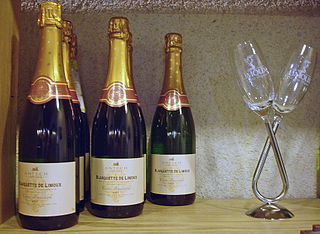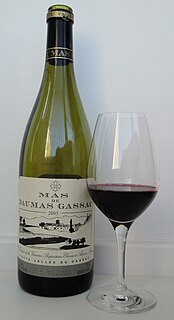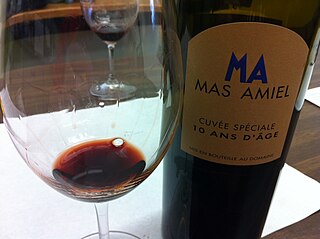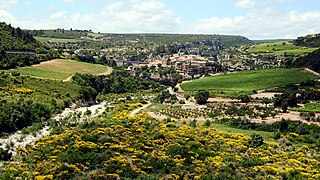 W
WBanyuls is a French appellation d'origine contrôlée (AOC) for a fortified apéritif or dessert wine made from old vines cultivated in terraces on the slopes of the Catalan Pyrenees in the Roussillon county of France, bordering, to the south, the Empordà wine region in Catalonia in Spain.
 W
WCabardès is an Appellation d'Origine Contrôlée (AOC) for red and rosé wine in Languedoc-Roussillon wine region in France. Cabardès was named after the Lords of Cabaret who defended the Châteaux de Lastours against Simon de Montfort in 1209. Despite the name's medieval origins, this appellation is one of the youngest in France, having only become official in February 1999.
 W
WCollioure is an Appellation d'Origine Contrôlée (AOC) for French wines situated around the town of Collioure in the Roussillon wine region of France. Red, rosé and a few white wines are produced-the reds from Grenache noir, Mourvèdre, Syrah, Carignan and Cinsaut grapes; the white are made from a blend of Grenache blanc and Grenache gris. The boundaries of the AOC are identical with the Banyuls AOC as many of the grapes grown in Collioure are destined for use in the fortified Vins doux naturels of the region. The grapes that do not get used for Banyuls are then produced as non-fortified still wines under the Collioure AOC.
 W
WCorbières is an Appellation d'origine contrôlée (AOC) for wine in the Languedoc-Roussillon, France, and it is this region's largest AOC, responsible for 46 per cent of the region's AOC wine production in 2005. Red wine dominates the production in Corbières with almost 95 per cent, with 3.5 per cent rosé wine and 2 per cent white wine making up the balance. Carignan is the most common grape variety. The AOC was created in 1985, covers 13,500 hectares of vineyards and produces an average of 554,000 hectoliters of wine per year, corresponding to 74 million bottles.
 W
WFaugères is an Appellation d'origine contrôlée (AOC) in the Languedoc-Roussillon wine region in France and is named after Faugères. It is also known as Coteaux-du-Languedoc Faugères and lies 20 km northwest of Béziers, on the hills of Hérault. It is a local classification within the Coteaux-du-Languedoc AOC.
 W
WFitou is a large French wine appellation in Languedoc-Roussillon, France. The dominant vine variety is Carignan which has to constitute 40% of any blend. Grenache, Lladoner Pelut, Mourvèdre and Syrah are also often blended with it. Muscat de Rivesaltes AOC, a vin doux naturel, also comes from the region.
 W
WFrontignan is a commune in the Hérault department in southern France.
 W
WLanguedoc-Roussillon is a former administrative region of France. On 1 January 2016, it joined with the region of Midi-Pyrénées to become Occitanie. It comprised five departments, and borders the other French regions of Provence-Alpes-Côte d'Azur, Rhône-Alpes, Auvergne, Midi-Pyrénées on the one side, and Spain, Andorra and the Mediterranean Sea on the other side. It was the southernmost region of mainland France.
 W
WLimoux wine is produced around the city of Limoux in Languedoc in southwestern France. Limoux wine is produced under four Appellation d'origine contrôlée (AOC) designations: Blanquette de Limoux, Blanquette méthode ancestrale, Crémant de Limoux and Limoux, the first three of which are sparkling wines and dominate the production around Limoux. The main grape of the region is the Mauzac, locally known as Blanquette, followed by Chardonnay and Chenin blanc. In 2005, the Limoux AOC was created to include red wine production consisting of mostly Merlot. Wine historians believe that the world's first sparkling wine was produced in this region in 1531, by the monks at the abbey in Saint-Hilaire.
 W
WThe AOCs for Languedoc-Roussillon wine include:
 W
WMaury is an Appellation d'Origine Contrôlée (AOC) for fortified vin doux naturel wines made in the Roussillon wine region of France. Almost all wines are red, made from at least 75% Grenache noir (Garnacha). Other permitted grapes are Grenache blanc, Grenache gris, Macabeu (Macabeo), Malvoisie du Roussillon (Tourbat), Syrah, Muscat and other local varieties. Although the grapes are different, they are used and marketed very much like port. It is made in the communes of Maury, Saint-Paul-de-Fenouillet, Lesquerde, Tautavel and Rasiguères. The AOC was granted in 1936.
 W
WMinervois is an AOC in the Languedoc-Roussillon wine region, in the departments of the Aude and of the Herault. Historically, the region's capital has been the village of Minerve.
 W
WMuscat de Rivesaltes is an Appellation d'Origine Contrôlée (AOC) for fortified wines made in the Roussillon wine region of France. They are similar to Rivesaltes AOC wines, except for the grape varieties used. The wines are white, and made from Muscat d'Alexandrie and Muscat à Petits Grains grapes, usually in equal quantities, although the appellation rules allow these varieties to be used in any proportion. The alcohol content must be at least 15 per cent by volume, the potential alcohol content at least 21.5 per cent, and the sugar content of the finished wine at least 100 grams per liter.
 W
WPiquepoul, Picpoul, or Picapoll is a variety of wine grape grown primarily in the Rhone Valley and Languedoc regions of France as well as Catalonia, Spain. It exists both in dark-skinned and light-skinned versions, as well as a very little grown Piquepoul gris. Piquepoul blanc is the most common of the Piquepouls, with 1,000 hectares cultivated in France in 2000, and an increasing trend.
 W
WRivesaltes is an appellation d'origine contrôlée (AOC) for naturally sweet, fortified wines. The name refers to both a production region within Languedoc-Roussillon in southern France, and the style of sweet wines produced there.
 W
WThe Saint-Chinian is a French wine, from the Languedoc-Roussillon wine region of France. It is usually a blend of several grape varieties, and produced in red, rosé, and white versions. Since 1982, the name is protected by an appellation d'origine contrôlée. Its terroir was named after the nearby village of Saint-Chinian.